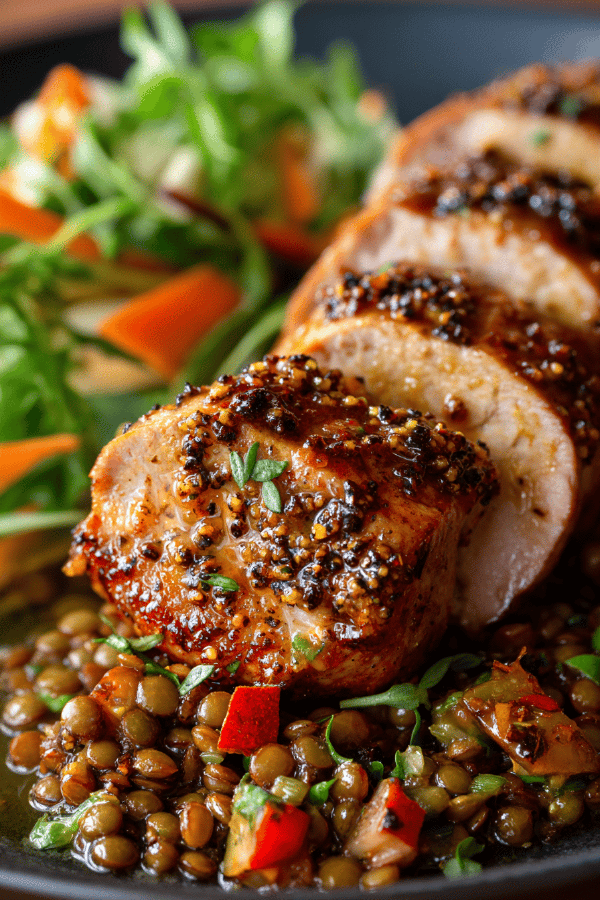Featured Recipe
Pork Tenderloin Espelette

By Kate
"
Tender pork tenderloins marinated in a blend of grainy mustard, lemon juice, smoked paprika, and a pinch of maple syrup for subtle sweetness. Cooked low and slow on a charcoal grill to seal juices and ensure tender bite. Piment d’Espelette swapped for smoked paprika and crushed Aleppo pepper for a smoky, mildly fruity heat. Balanced acidity and sweet undertones. Accompanied by a warm lentil salad bursting with fresh herbs and diced veggies. No gluten, nuts, dairy, or eggs. Refined timings and techniques prioritize sight, smell, and touch over rigid clocks.
"
Prep:
20 min
Cook:
20 min
Total:
40 min
Serves:
6 servings
grilling
pork
French cuisine
healthy eating
meal prep
Introduction
Tender, juicy pork. Not dry, never tough. That margin of error tight. No guesswork. The marinade takes charge. Grainy mustard gives texture deep down, lemon juice unravels the fibers just so—an edge of acidity cuts through dense protein. Smoked paprika swapped for Espelette brings subtlety, mild fruit heat with smoky notes; maple syrup substitutes sugar for more complex sweetness. The meat soaks in flavors for hours, no rush. Grill hot first, sear crust fast, then drop heat; slow it down for even cooking. Meat cracks, sizzling fat renders. Resting—crucial—locks those juices inside muscle fibers again. Slice precisely, against grain, to make every bite tender. A simple warm lentil salad with fresh herbs finishes sharp and fresh. Traditional but with twists adapting to what’s in your pantry.
Ingredients
About the ingredients
Swapping piment d’Espelette for smoked paprika and adding a touch of crushed Aleppo pepper at plating shifts heat profile. Espelette sometimes scarce; paprika adds smoky warmth without overpowering. Maple syrup replaces white sugar—adds complexity and moisture, avoids dryness common with pure acid marination. Dijon mustard grainy for texture; smooth mustard can be used but loses visual and tactile contrast. Lemon juice best fresh—bottled lacks brightness. Tenderloins can vary; thicker ones require closer attention to heat zones to avoid raw centers or dry exteriors. Coat well but don’t drown in marinade to avoid mushy surface—marinate between 8 and 36 hours, any longer acid breaks down beyond desired level.
Method
Marinade
- Mix mustard, lemon juice, smoked paprika, maple syrup, and salt in a glass dish. Stir briskly to combine sharp acidity and smoky notes with a hint of sweetness.
- Add tenderloins into marinade, turn to coat thoroughly. Cover with plastic wrap. Refrigerate 8 to 36 hours; can go longer but acidity will start to break down surface texture too much. Not a soak but a flavor penetration.
- Preheat charcoal or gas grill to high. Aim for hot coils, around 230-260°C surface temp. Brush grates with olive oil to prevent sticking. Listen for immediate sizzle when meat hits the grill.
- Place tenderloins on hottest part. After 3 minutes, reduce heat to medium-low or move to indirect zone. Grill turning every 3-4 minutes to create even crust without burning sugars in marinade. Total cook time about 18-22 minutes, depending on thickness. Flesh should firm yet yield slightly to finger pressure, juices clear but not drying.
- Feel for bounce, not resistance. Color deep golden-brown speckled with smoky char edges. Listen for fat crackle and aroma shifts from sharp mustard to rich caramel.
- Transfer meat to cutting board tented loosely with foil. Rest 8-10 minutes to redistribute juices. Slice against the grain into medallions about 1-1.5 cm thick.
- Plate alongside warm lentil salad dressed with herbs and crisp diced veg. Optional sprinkle of crushed Aleppo pepper for mild heat contrast. No need to overspice; balance is key.
Cooking Prep
Grilling
Rest & Serve
Technique Tips
Marinate first to break down pork’s dense muscle fibers gently but avoid over-tenderizing. Glass dish recommended for non-reactive surface to prevent bitterness from mustard and acid. Hot grill essential for sear—listen for immediate sizzle as sign meat hits right temp. Reduce heat after initial sear to prevent burning delicate maple sugar. Turn often; uneven charring means either too hot or stagnant air flow. Meat ready when surface feels firm but springy, juices run lightly clear when pricked. Resting crucial; without it, juices run out immediately slicing—lose flavor and moisture. Slice uniformly against grain; follow muscle fibers direction by eye. Warm lentil salad adds texture and herbaceous freshness to balance meat richness. Crushed Aleppo pepper optional but lifts flavor without sharp burn.
Chef's Notes
- 💡 Choose quality pork tenderloins. Look for a nice pink color and marbling. Avoid if too dark or dry looking. Too thin won’t cook evenly.
- 💡 Marinate longer for deeper flavor. 8 hours minimum, up to 36 works. But be careful. Acidity breaks down meat too much. If mushy, you messed up.
- 💡 Grill temp matters. High for sear first; aim 230-260°C. Listen for that sizzle when the meat hits. If no sound, grill’s not ready.
- 💡 Rest meat after cooking. Tent with foil. Wait at least 8 minutes. Juices redistribute. Cut too soon, they run out. No one wants dry meat.
- 💡 Serve with lentil salad. Fresh herbs, diced veggies add crunch. Balance richness of pork. Toss lentils lightly. Simple dressing, keeps it fresh.
Kitchen Wisdom
What's best way to marinate?
Use glass dish, not metal. Acid reacts. Ensure even coating. No drowning; too much marinade = mushy outside.
Can I grill indoors?
Sure, use grill pan. Cast iron is best for heat retention. But smoke and grease—open a window. Watch the temp.
How to tell when meat is done?
Press gently with fingers. Should feel firm, bounce back. Juices clear when pricked. Internal temp ideally 63°C.
Any storage tips?
Fridge for 3-4 days in airtight container. Try freezing. But can dry out if not wrapped well. Thaw gently.



